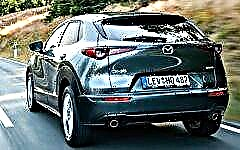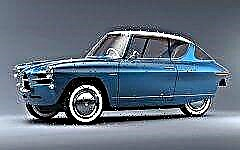

The content of the article:
- Estonian electromobility
- The spool is small, but it is good
- Go to the electric car
The small Baltic countries lead their life quietly and not pretentious, from which the world community does not cease to be amazed at their unpredictable actions and achievements. One of the latest sensations was the Estonian car Nobe 100 EV, an amazing retro model with an electric motor.
Estonian electromobility

It was Estonia that initiated the Let’s do it movement on global garbage collection and elimination of unauthorized landfills in the country, which was subsequently taken up by many world powers. Now the government has set itself a goal - to completely switch to environmentally friendly electric cars.
Since 2011, the ELMO electromobility project has been operating in the country, within the framework of which 507 iMiev electric cars were immediately purchased from Mitsubishi Corporation for the needs of social services. The basic concept of this comprehensive program is threefold:
- popularization of electric cars;
- financial support for potential car owners;
- development of appropriate infrastructure, including equipping the country with charging stations.
To stimulate consumer interest in electric cars, the Estonian government has tried to make them as accessible as possible to its citizens. For this, the financial company KredEx provides individuals and organizations with a state grant in the amount of up to 50% of the value of the car, while the maximum amount cannot exceed 18,000 euros.
In addition to assistance in purchasing an electric car, KredEx will additionally reimburse up to 1000 euros from the cost of a home charger.
Within the framework of the state program a full-fledged network of electric filling stations operates in Estonia, which operate not only on major highways, but also in small towns with a population of 5 thousand people. When installing the stations, they even took into account the fact that the average charging time of an electric car to 80% takes on average half an hour, even with the use of "quick" refueling, and therefore they were placed at a distance of 40-60 km from each other.
For those who are not in a hurry, there are 500 units of "slow" electric stations that charge the car in 4-10 hours... It is convenient to use such stations if the owner goes to the cinema or for shopping, and can leave the car to charge for now.
But even this is not all: the owners of electric cars will receive the right to free parking, and in the absence of sufficient funds to buy their own car, they can simply rent a car. As practice shows, citizens in any case remain in profit - that renting an electric car, that refueling their own with electricity is much cheaper than maintaining a traditional car.
Thus, the authorities managed to achieve the impossible - to equate the cost of an electric car with conventional cars with an internal combustion engine, making it attractive to the population.
The spool is small, but it is good

Seeing a three-wheeled retro miracle, few people think that this is a modern electric car capable of covering 220 km of the track on a single charge. Estonian car manufacturers have created a unique model: classic look, high technology, practicality and agility. Although the baby is not capable of speeds over 100 km / h, this is not required of her - the Nobe 100 is created exclusively for city streets.
It was not by chance that Roman Mulyar chose this look for his brainchild, considering it the highest degree of design genius. The Nobe 100 advertising slogan sounds like "Something so stylish that you want to lick it"... As a prototype, Mulyar considered the Volkswagen Beetle, the Messerschmitt Cabenroller, and the Italian sports cars of the 1950s. As a result, the car embodied uniqueness with the classics, reasonable practicality - with reckless gaiety while traveling.
Its body is made of lightweight composite materials, and the rigid removable top allows you to turn the car into the world's first electric convertible with a flick of your hand.
The charming teardrop-shaped design is designed for three people (driver and passenger in the front, as well as a narrow sofa behind), has a luggage compartment, an all-wheel drive system and the ability to accelerate to 100 km / h in 5.9 seconds.
An undeniable advantage is the compact size of the Nobe 100, which makes it easy to maneuver in traffic and park even in the most difficult conditions.
Minimalistic interior, partially spied on from the Pagoda SL, mostly taken from the 30s: switches and door handles in chrome, white and wood trim, metal analog gauges. Moreover, the retro style is applied so much that even the glass will have to be lowered in the old fashioned way, turning the knob, and there is not a single display on the dashboard.
In addition, one should not rely on such primitive benefits of civilization as a multimedia system or a cup holder. Even seemingly simple and familiar things in Nobe 100 look non-trivial. So, for the aesthetics of the replaceable battery located under the dash and weighing only 18 kg, the designers gave the look of a leather case.
The little "Estonian" owes all these delights to the British designer Jim Stokes, who owns a company for the restoration of Italian oldtimers. Since his company carries out not only comprehensive restoration, but also independently produces copies of various components for Alfa Romeo and Lancia, it should be assumed that Stokes' role in the life of an electric car will not end with the release of the Nobe 100.
The creators claim that a full charge of an electric car is able to gain in 2 hours, and for long trips has an additional battery.
Go to the electric car

At the moment, the Nobe 100 is presented only in the form of a computer render, and its specifications have not yet been fully thought out. For active work on the project, financial resources are needed, and considerable funds - the developers roughly estimate the cost of the electric car at 34 thousand dollars. To raise money, Roman Mulyar launched a crowdfunding campaign with the aim of attracting funds from everyone who wants to sponsor the production of a national electric car.
The current budget allows for the production of no more than two models per year, for which there is already a pre-order with a prepayment made. True, some auto experts and consumers consider the cost of an electric car disproportionate to its inner asceticism. If the promotion raises the required amount of $ 1.2 million, then the release of the retro handsome man could begin in 2020.
It is difficult to unequivocally predict the future of the first Estonian electric car, but the active position of the government, aimed at maximizing the electric mobility of its citizens, speaks in its favor.
In general, there is a stable interest in this kind of transport. When several dozen electric cars were purchased for the Estonian taxi fleet several years ago, no one, even the chairman of the electric taxi company Ermo Kontsson, did not expect that the idea would be in demand. However, people are quite willing to change to new cars, evaluating convenience and economy. Konson is confident that sooner or later a fuel crisis will break out, and it will become absolutely unprofitable to maintain classic gasoline and diesel cars. In addition, he proposes to abolish the tax on imports of electric vehicles, as many other countries have already done.
The first is not computer-based, but full-fledged concept Nobe 100 should be available by October 2018to set off to conquer the Paris Motor Show.The working group also included Meelis Merilo, who once headed the ZEV company, which was engaged in non-standard projects of an electric car based on the Russian Pobeda, the ZEV 7 coupe, partly reminiscent of the LotusSeven sports car, and the three-wheeled ZEV ELVE model.
There are no eminent craftsmen in the team: Jim Stokes has a talent for restoring car classics, which he has been doing for 40 years, three employees have already proven themselves in Formula Student, and Peter Westerbacka, the creator of the game Angry Birds, is responsible for marketing. All 12 employees of the company, among whom are mainly graduates of Tallinn University, are confident in the success of their development.











